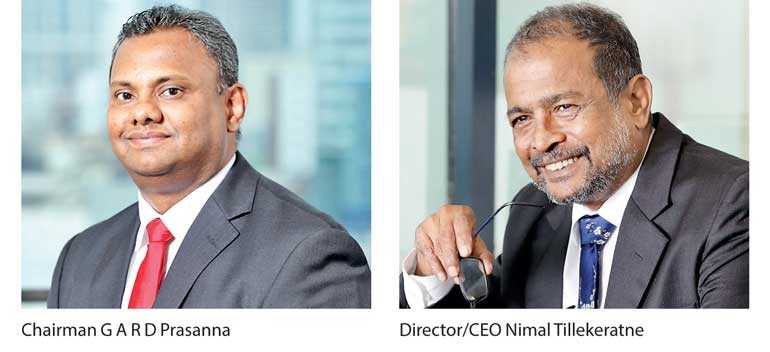Tuesday Jan 20, 2026
Tuesday Jan 20, 2026
Friday, 27 April 2018 00:00 - - {{hitsCtrl.values.hits}}

Pan Asia Banking Corporation Plc said yesterday it had reported Rs. 498.0 million in profit before tax for the quarter ended 31 March 2018 (1Q’18), powered by a steady growth in new loans and improvement in overall margins which was the result of prudent asset-liability pricing amidst rising market interest rates.
This enabled the bank to increase its net interest income by 11.0 % to Rs. 1.34 billion for the quarter from the Rs.1.21 billion recorded in the same period last year.
Meanwhile, the core banking performance was aptly supported by non-fund based incomes such as fee incomes and trading gains. The bank managed to increase its net fee and commission income by a modest 8.0 % to Rs. 368.12 million from the same period in 2017.
Meanwhile, the net trading gains rose sharply to Rs. 199.58 million during the quarter from Rs. 69.83 million in the same period a year ago as the bank sold its short-term investments in the trading portfolio, realising a sizable capital gain.
As a result of these fund and non-fund based incomes, the bank increased its total operating income by 17.0% year on year to Rs. 1.99 billion.
The sound top-line performance was somewhat softened by the higher provisions made against possible bad loans and the higher tax liability for the period.
The collective impairments rose sharply to Rs. 183.83 million from a previous year reversal of Rs. 38.32 million due to the relatively strong growth in the new loans across all segments – Corporate, Retail, SME and Credit Cards. Collective impairments rise as new loans grow.
The individual impairments or the provisions made against selected individual customers declined by 8% during the quarter against the same period last year as few clients settled their facilities resulting in the reversal of provisions made earlier for them.
The income tax charge for the quarter was Rs. 185.16 million, up 16 % from the same period last year which resulted in a profit after tax of Rs. 312.8 million, down 11.0 % from the same period last year.
Speaking on the first quarter financial performance, Pan Asia Bank’s Director/Chief Executive Officer Nimal Tillekeratne said that although the bank witnessed a temporary slowdown in the bottom-line during its first quarter, the bank was now on a path of steadfast growth with built-in resilience across all areas of operations which will reflect positively in the financial results in the coming quarters.
“After a year of internal restructuring, re-strategising and policy re-setting, now is the time the bank is slowly gaining its growth momentum.
“We need sustainable and durable growth, hence we will gradually accelerate our growth while tightening our credit underwriting standards, risk management and post disbursement monitoring to ensure that there won’t be any negative spillover effects on asset quality from our business growth going forward,” said Tillekeratne, confiding that the bank would out-gross its revenues and profits in the coming quarters.
Pan Asia Bank grew its gross loans and receivables book by Rs. 8.38 billion in the three months to Rs. 119.73 billion by the end of March.
This translates into an annualised growth of Rs. 34 billion for the entire year which further translates into a solid 30% growth in the loan book.
The bank had an asset base of Rs. 146.66 billion by 31 March 2018, up 6.0 % from December 2017. The gross non-performing loan ratio – the proxy for asset quality in the bank– was 4.40 % compared to 4.36 % in December 2017 and significantly down from 5.63 % a year ago.
Meanwhile, the bank’s deposit base grew by Rs. 5.35 billion or 5.0 % during the three months to Rs. 112.5 billion.
As a result of the reallocation of funds into more remunerative areas in the asset portfolio plus the prudent asset-liability re-pricing in line with the rising market interest rates, the bank was able to increase its net interest margin to 3.80 % from 3.61% in December 2017.
Meanwhile, by the end of March, the bank’s capital adequacy levels against the BASEL III accord remained above the minimum requirements.
Accordingly, the Common Equity tier I ratio and the tier I ratio stood at 10.66 % each against the regulatory minimums of 5.75% and 7.25% respectively.
The total capital adequacy ratio or the tier II capital ratio stood at 12.53 % against the regulatory minimum requirement of 11.25%.
In recognition of the continued expansion in the bank’s franchise, the bank was presented with the award for the Fastest Growing Commercial Bank in Sri Lanka for the fourth consecutive year in 2017 and was also recognised at the National Business Excellence Awards 2017 – the benchmark business excellence competition conducted by the National Chamber of Commerce of Sri Lanka.